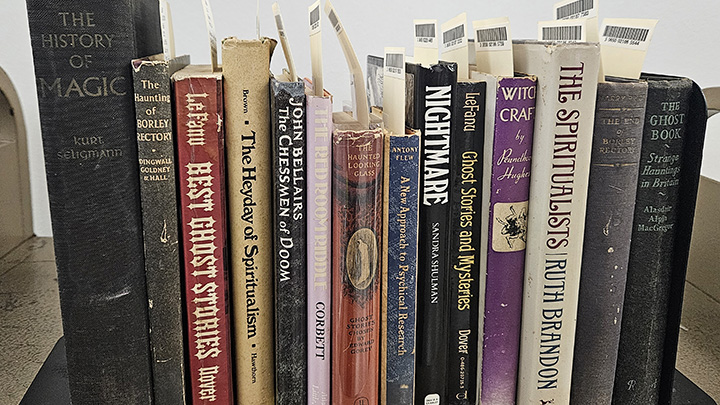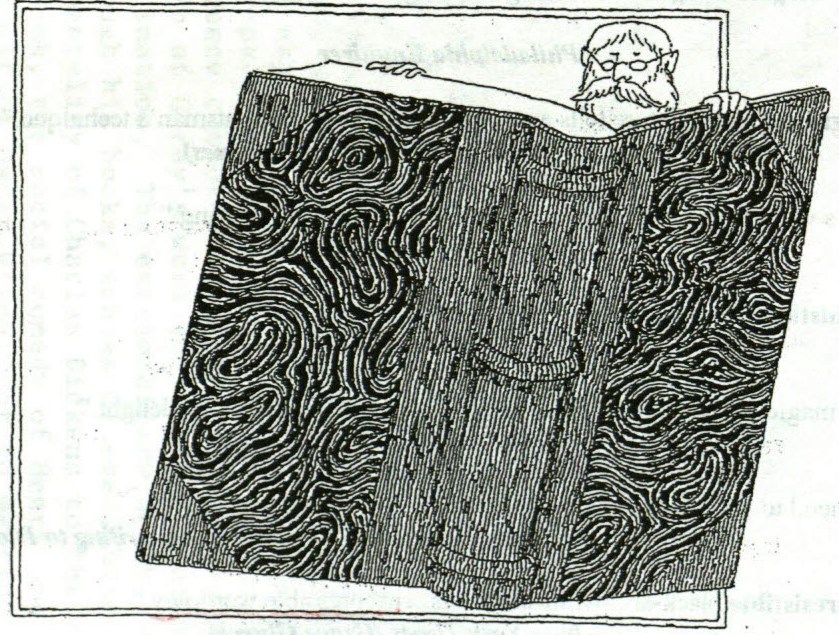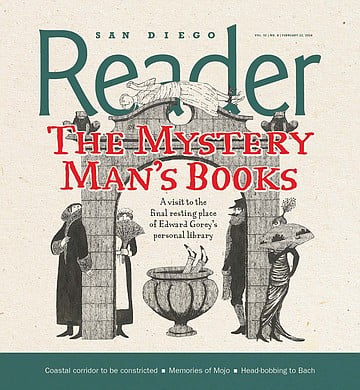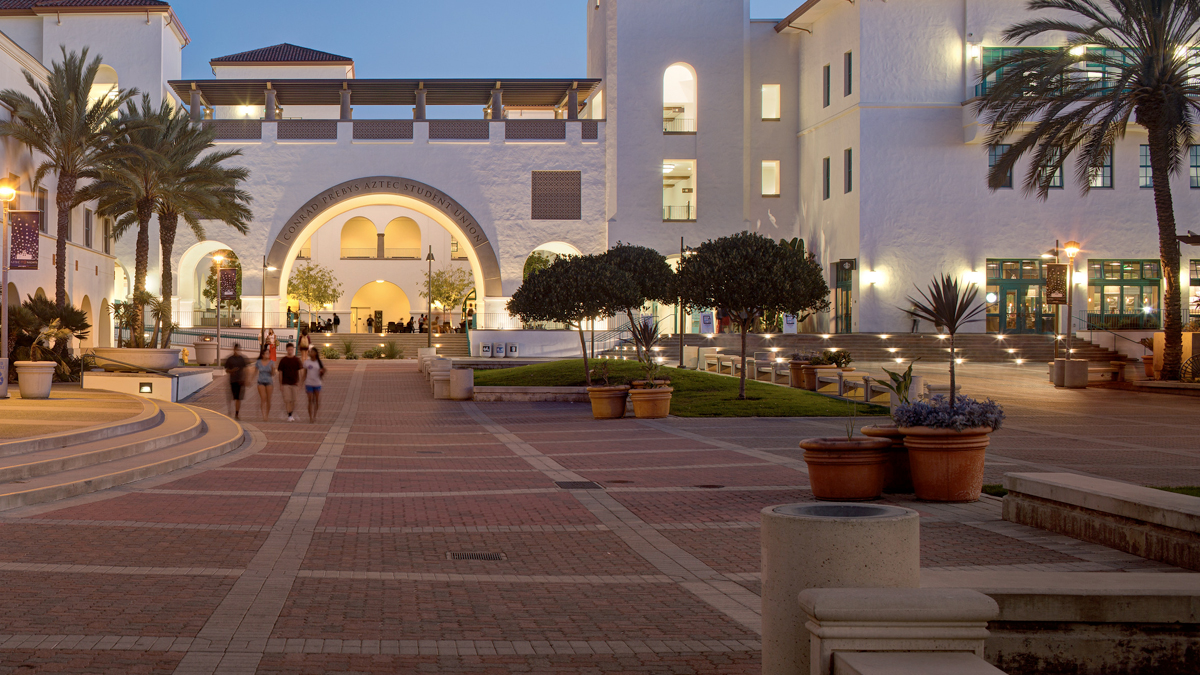A Treasure of the Library - The Edward Gorey Personal Library

Tucked away in a hidden suite of rooms on the fifth floor of Love Library is the Edward Gorey Personal Library. The collection includes over 26,000 books, including ephemeral notes and scribblings Gorey slipped into these books.
You might be asking yourself, who is Edward Gorey? He was an artist, author, illustrator, children's book designer, and theater designer. Gorey was also a puppet show creator, a button maker, a cat lover, and a purveyor of 20th-century nonsense who inspired the likes of Tim Burton. His most well-known works include “The Gashlycrumb Tinies (1963),” “The Doubtful Guest (1957),” and “The Wuggly Ump (1963).” He might be familiar as the illustrator of the opening sequence of PBS’s “Mystery.” His set designs for the 1970s Broadway run of Dracula set an iconic Gothic tone for a generation. He was born in 1925 and passed away in 2000, and his personal library arrived at SDSU in 2009.
How did this collection come to reside at SDSU? Gorey collaborated with Dr. Peter Neumeyer, the founder of the National Center for the Study of Children's Literature at SDSU, on three children's books: “Donald and the…(1969),” “Donald Has a Difficulty (1970),” and “Why We Have Day and Night (1970).” Gorey and Neumeyer kept up a correspondence that Neumeyer documents in his book “Floating Worlds: The Letters Of Edward Gorey & Peter F. Neumeyer (2011).” Another connection was SDSU alumnus Andreas Brown, owner of New York City's Gotham Book Mart, where Gorey purchased books. To hear more about this connection to SDSU, listen to the oral histories “An interview with Peter Neumeyer, “A talk Given by Andreas Brown,” and an interview of Linda Salem by the Edward Gorey Charitable Trust.

Gorey’s personal library encompasses an amazing variety of subjects: African art, art, art history, ballet, biography, British novels, children's literature, detective fiction, fiction, general literature, games, gardens, gothic literature, history, hymns, illustration, India, Japan, mystery, poetry, French culture, French history, and French literature and novels. Over 9,000 items from the Gorey Collection have been processed and can be found through the library catalog. We continue working on this expansive collection of more than 26,000 volumes.
Of particular interest at this time of year are the many books on haunted houses, ghosts, and other spooky things. Gorey used his extensive library to inspire his illustrations and once said, “It all comes from books.” He had a particular obsession with death which he explored through the lens of surrealism. When asked, “Do you fear death? Do you think about it often?” Gorey replied, “I think about it constantly. Doesn't everyone?” He is particularly well known for his depictions of death (often quite gruesome) in books intended for children.
Linda Salem, librarian for the Gorey Collection said, "Even though the collection is by no means haunted, encounters with the collection exude serendipity in a way that benefits students. Years ago, an art student at the reference desk asked me for the book "Colour and Meaning. Art, Science, and Symbolism" by John Gage. The SDSU Library did not have a copy. That same day, working in the Gorey collection, one of the first things that caught my eye was the beautiful pale blue cover of "Colour and Meaning" by John Gage peeking out of the end of one of the shelves. The copy had not yet been cataloged so it wasn't findable by the Library's online system yet. So, the library cataloguers rush cataloged the book for the student, and we made it available for them to use. Now, years later, this book is available online for students. But, back then, Gorey seemed to be on board, through his collection, helping SDSU art students."
The Edward Gorey Personal Library is a working collection. Through her exhibits, publications, papers, and events about the collection, Salem seeks to share the collection with Gorey scholars and fans. Exhibit curators, authors, and instructors) have relied on Salem's help using the Edward Gorey Personal Library to accomplish their goals. Some notable examples include:
- "The Journey to the World of Edward Gorey" Exhibit Catalog. Salem provided the exhibit curator/researcher with a bibliographic list of 19th-century books in the Personal Library to show through the exhibit how Edward Gorey was influenced by books published 1800-1899.
- "Gorey's Worlds. A Peak Into the Peculiar Mind of Edward Gorey." Exhibit at the Wadsworth Atheneum Museum of Art. The curator of the exhibit provided a list of artworks and images exhibited by Edward Gorey in his home and asked Salem to identify art books held in Gorey's Personal Library that corresponded to each of the listed artists.
- “Born to Be Posthumous. The Eccentric Life and Mysterious Genius of Edward Gorey.” by Mark Dery. Salem provided the researcher with bibliographic research support identifying cataloged and uncatalogued books in the Personal Library on selected themes.
- Salem also wrote "The Edward Gorey Personal Library. Evidencing Insights." Section V, Chapter 15 in “Frontiers in American Children's Literature.”

The collection also inspired a story in the San Diego Reader last year.
Salem also uses the collection in her teaching, including lectures on the history of children’s literature illustration. Gorey taught courses in children's literature that covered nonsense authors Edward Lear and Lewis Carroll to illustrators from Walter Crane, Kate Greenaway, Randolph Caldecott, and many more. Salem continues his tradition in her own presentations.
We will mark the centenary of Gorey's birth next year. Salem is working to create a digital collection of ephemera found in the Personal Library. She is working closely with the Edward Gorey Charitable Trust as it plans “A yearlong birthday party full of programs, partnerships, and new product launches.”
The Edward Gorey Personal Library is not open to the public but can be accessed for research through an appointment with the library’s Special Collections department. Meanwhile, check out other books suitable for Halloween on display on the 1st floor of the Dome.

